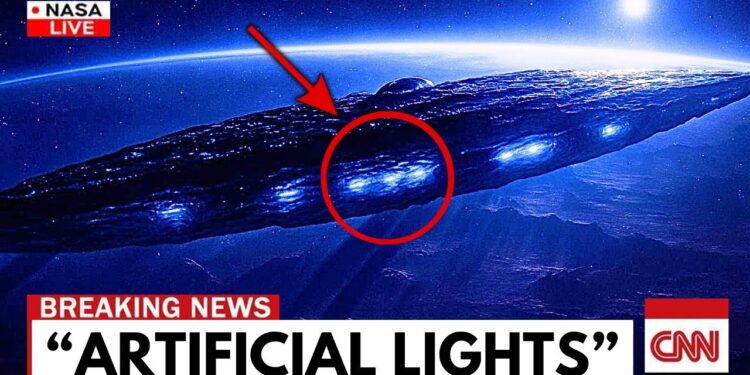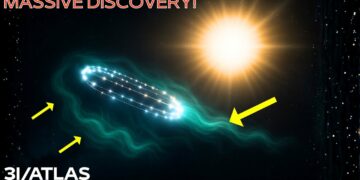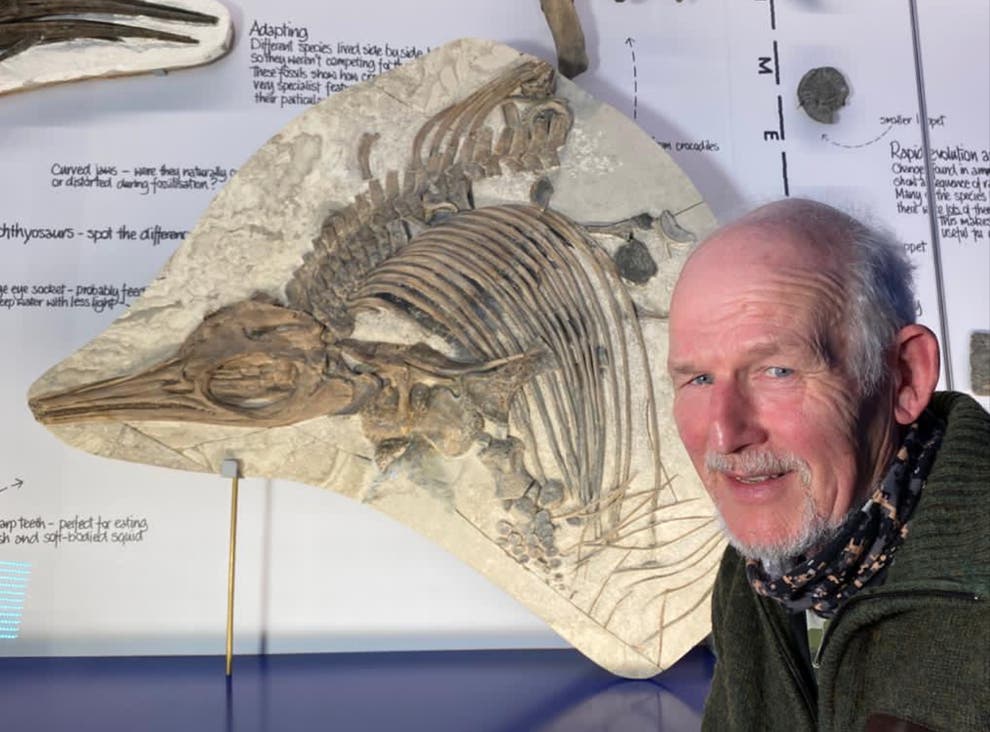For decades, humanity has gazed at the stars, searching not only for planets or signals but for anomalies—those rare instances when the cosmos defies the rules. The James Webb Space Telescope may have just uncovered one such anomaly, transforming a routine observation into a chilling discovery. What began as an analysis of the third interstellar object ever recorded in our solar system, dubbed Three Atlas, has revealed something far stranger, darker, and infinitely more significant.
Deep in the cold void beyond Mars, the Webb telescope detected something inexplicable: not just light, but artificial light. This glow, unlike that of any comet or asteroid, defies the known physics of reflection or refraction. Its behavior—steady, rhythmic, and unnatural—has left astronomers grappling with a question that sends shivers down their spines: What is Three Atlas really? This discovery has reignited humanity’s oldest and most unsettling question: Are we alone?
A Cosmic Curiosity Turns Uncanny
Three Atlas was first detected as a faint speck on the edge of our solar system, moving along a trajectory no local object could follow. Clearly interstellar, it was born beyond our sun’s gravitational pull, propelled across the galaxy by an unknown force. Initially, it was treated as a curiosity, akin to its predecessors, ‘Oumuamua and Borisov. Yet, something about Three Atlas felt off from the start. Unlike typical interstellar objects, it was unusually bright in a way that defied explanation. Its magnitude didn’t align with its estimated size or composition, shimmering with an unnatural consistency—neither fading as expected nor flaring with signs of outgassing or dust release.
Traditional comets brighten in bursts as ice sublimates, but Three Atlas remained steady, as if powered from within. Telescopes worldwide turned to observe it, and the James Webb Space Telescope, with its unmatched infrared capabilities, was tasked with unraveling the mystery. What it found changed everything.
A Telescope’s Unsettling Revelation
Positioned a million miles from Earth at the Lagrange Point, the Webb telescope was designed to pierce the glare of stars and reveal hidden cosmic truths. Its gaze upon Three Atlas was expected to clarify the object’s nature. Instead, it deepened the enigma. The telescope detected a centralized thermal emission that didn’t correspond to natural sunlight reflection. Unlike a comet, which shines by reflecting sunlight off dust and ice, Three Atlas emitted an internal heat signature radiating from its core. This wasn’t scattered light—it was emitted light.
The thermal mapping revealed a pattern that followed no known natural distribution curve. It pulsed faintly, irregularly, and most disturbingly, it cycled at intervals, suggesting not randomness but design. NASA and the European Space Agency proposed exotic explanations—radioactive decay, subsurface friction, or alien isotopes—but as data accumulated, these theories crumbled. The only consistent explanation left was one no one dared to commit to paper: Three Atlas might be powered.
A Profile Unlike Any Celestial Body
As data from Webb, Hubble, and terrestrial observatories poured in, a profile of Three Atlas emerged—one that resembled no known celestial body. Its trajectory was too precise to be chaotic, as if it were deliberately navigating through gravity wells. Its rotation was unnaturally stable, defying standard inertial drift. The absence of a cometary tail, even near solar radiation, suggested a protective shell or casing. Most shockingly, its albedo—surface reflectivity—was nearly perfect in parts, resembling polished metal rather than rock, ice, or dust.
This metallic signature sent shockwaves through the astronomical community. If Three Atlas was metallic, structured, and emitting energy, it wasn’t a natural object—it was technology. Terms like “probe,” “beacon,” “craft,” and even “artifact” began circulating in hushed institutional emails behind encrypted firewalls. The idea of an alien spacecraft, once confined to conspiracy forums, was now a serious consideration.
The Chilling Light of Three Atlas
The most damning evidence wasn’t the trajectory or the metallic signature—it was the light. Photometric analysis revealed that the light from Three Atlas was focused in a narrow spectrum band, unlike the broad reflection of sunlight from natural objects. This controlled emission of specific wavelengths mirrored technologies like LED arrays, laser communication systems, or spacecraft signal beacons. The light’s intensity even seemed to adjust slightly in response to solar radiation, as if an onboard system were modulating it in real time. The flickering wasn’t random but followed an intermittent pulse.
Astronomers ran the data through known signal models, yielding inconclusive but provocative results. Some claimed the pulses resembled binary sequences, while others suggested a rotating power source. The conclusion was inescapable: this was not a passive object. It was doing something, deliberately.
A Signal Buried in the Noise
A team from MIT and Harvard conducted a deep signal analysis of Three Atlas’s electromagnetic emissions. Initially, the frequencies appeared random, mere noise scattered across the spectrum. But when Fourier transforms isolated cyclical patterns, a structured, repeating pulse emerged—too precise to be natural. It wasn’t standard binary or human modulation, but it bore the hallmark of intentional encoding. Some speculated it was a beacon broadcasting to unknown receivers, while others suggested telemetry sent back to its origin. Most unsettlingly, the signal remained unchanged since its detection, as if Three Atlas were communicating not with us, but with someone else.
A Cosmic Threat or an Ancient Observer?
News of the discovery reached the highest levels of scientific and defense institutions. A leaked NASA report revealed coordination with global space agencies to assess whether Three Atlas posed a threat. Some argued it was benign—an ancient probe on a pre-programmed route. Others were less optimistic, raising unanswerable questions: If it’s transmitting, who’s receiving? If it emits light, does it have propulsion? If it’s here by design, why now?
The report hinted that Three Atlas might not be merely passing through but observing—tracking planetary alignments, electromagnetic fields, or even advanced civilizations. This possibility sparked panic behind the scenes. If Three Atlas wasn’t alone, something else might be coming.
Harvesting the Sun’s Energy
Further analysis suggested Three Atlas wasn’t just emitting energy—it was harvesting it. Its light output fluctuated with its proximity to the sun, and the absence of chemical reactions pointed to a solar collection array or photonic absorption system. Theorists proposed that the dust cloud surrounding the object might serve as both camouflage and a medium for absorbing solar radiation. If true, Three Atlas could be a self-sustaining craft designed to travel indefinitely, activating only when nearing a star system worth investigating. Our solar system may have triggered that activation.
An Unprepared Humanity
As international space agencies scrambled for answers, one truth became clear: humanity is unprepared. Despite decades of speculation about extraterrestrial contact, our systems—political, scientific, and philosophical—are ill-equipped to process Three Atlas’s implications. No official statements have been made, but leaked documents from France, Japan, and Brazil suggest a shared conclusion: this could be a first encounter unfolding in slow motion.
Unlike Hollywood’s dramatic landings, there’s no sudden appearance, no clear answers—only data, light, and silence. The Webb telescope continues to observe Three Atlas daily, yet each answer raises more questions. If this is contact, it’s on their terms—quiet, distant, and unsettling.
A Sudden Shift and a Cosmic Ping
Just when Three Atlas’s trajectory seemed predictable, its luminosity spiked by nearly 40% in under two minutes—a sudden flare with no natural explanation. This wasn’t caused by solar wind, impact, or disintegration. It was as if a switch had been flipped, possibly triggered by proximity to our star or our observations. The flare was accompanied by a shift in trajectory, a subtle but measurable course correction toward the plane of Earth’s orbit. This wasn’t a passive drift—it was a maneuver.
Spectroscopic analysis revealed traces of reflective alloys, rare earth elements, and compounds resembling theoretical quantum materials, suggesting either unfathomable age or advanced manufacturing. These weren’t natural materials—they were engineered.
A Bold Experiment and an Eerie Response
In a daring move, the SETI Institute transmitted a radio pulse toward Three Atlas, containing mathematical constants, the periodic table, and visual representations of humanity—a cosmic handshake. After a week of silence, a Chilean monitoring station detected a narrow-band return pulse, timed precisely 72 hours after transmission. It wasn’t an echo or reflection but a processed signal, implying something had received, calculated, and responded deliberately.
Interference and Silence
Following the ping, observatories worldwide reported technical anomalies—erratic thermal mappings, gyroscopic fluctuations, and data stream freezes when focused on Three Atlas. These glitches occurred in synchronized windows, suggesting selective interference. A theory emerged that Three Atlas was jamming our observations, controlling what we could see. If true, it wasn’t a passive visitor—it was a scout.
Public data streams were restricted, and agencies like NASA and the ESA issued vague statements about recalibrations. The astrophysics community split, with some believing the truth was being validated, others suspecting it was being suppressed.
A Mathematical Message
In a final effort, astronomers and mathematicians turned to pattern recognition. They discovered that Three Atlas’s path followed a Fibonacci arc, a spiral found in nature and communication protocols. Its course corrections, light flares, and ping response correlated with prime number sequences—patterns too precise to be natural. This wasn’t just a probe; it might be a message encoded in its behavior. We may have decoded the first word.
The Uncomfortable Truth
Three Atlas is no mere rock. Its unnatural light, calculated trajectory, rare materials, and deliberate signals point to one conclusion: we are not alone, and we may not have been for a long time. The James Webb telescope, built to witness the birth of galaxies, may have glimpsed something designed to observe us—something ancient, deliberate, and watching from the edge of our solar system.
Agencies remain silent, data is withheld, and the world seems unprepared. Yet we saw the light, tracked the path, and now face the question that terrifies even the most rational minds: What happens next? Is Three Atlas a lone cataloger, or the first of many? The countdown may have begun, and the universe reminds us: we are not the center—we are the observed.























